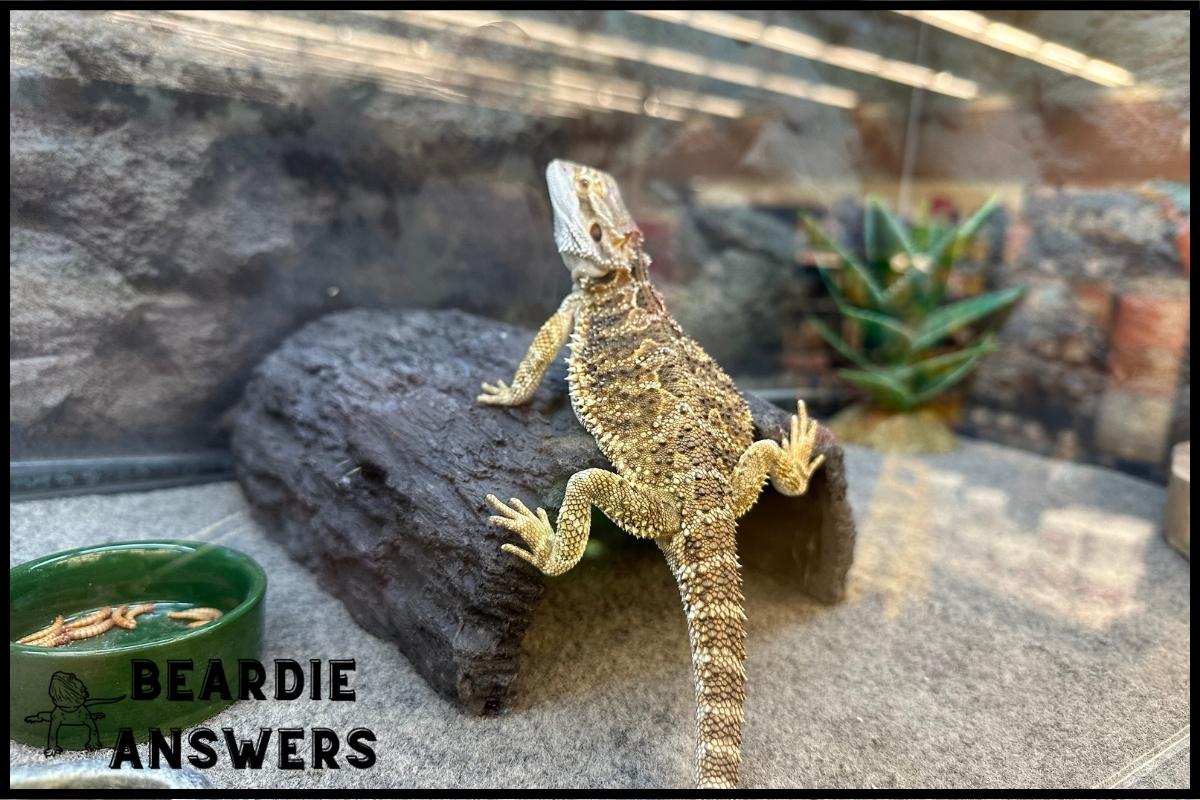Signs of unhealthy ears in bearded dragons can include discharge, swelling, and redness. If you notice any of these symptoms, it’s important to seek veterinary care for your bearded dragon. Additionally, proper hygiene and cleaning of the enclosure can help prevent ear infections and other health issues.
What You'll Learn
- 1 Causes Of Unhealthy Ears In Bearded Dragons
- 2 Identifying Unhealthy Ears In Bearded Dragons
- 3 Diagnosing And Treating Unhealthy Ears In Bearded Dragons
- 4 Prevention Of Unhealthy Ears In Bearded Dragons
- 5 Common Illnesses Associated With Unhealthy Ears
- 6 How To Clean And Care For Bearded Dragon Ears
- 7 Conclusion
Causes Of Unhealthy Ears In Bearded Dragons
The ears of a bearded dragon are like the canary in the coal mine, telling us when something is wrong. When their small but sensitive organs start to show signs of distress, it could be an indication of underlying issues such as environmental stress or risk factors that need our attention and care.
It’s important to know what these symptoms look like before we even get close enough to identify them; so let’s take a look at some causes for unhealthy ears on this unique pet reptile.
One major cause of ear problems in dragons can be attributed to poor husbandry practices or inadequate living conditions. A lack of proper nutrition, humidity levels, temperature regulations, cleanliness and other necessary elements can lead to infection and other serious health risks if not corrected quickly.
If your lizard isn’t given enough UVB exposure from sunlight or a lamp specifically designed for reptiles, they may also suffer from metabolic bone disease which can cause further damage to their delicate hearing system.
Environmental stressors such as loud noises, crowds or sudden changes in surroundings can also play a role in making your dragon’s ears susceptible to infections and irritation. Excessive handling or holding them incorrectly with two hands can put extra pressure on their necks which then affects the nerves surrounding the head area including their ears – leaving them prone to inflammation and potential trauma over time.
Having knowledge about these potential threats gives us insight into how best to protect our four-legged friends against any future discomfort. Identifying unhealthy ears early on requires understanding what healthy ones should look like first…
Identifying Unhealthy Ears In Bearded Dragons
Identifying unhealthy ears in bearded dragons can be challenging, as the symptoms are often subtle. The most common signs of an unhealthy ear include discharge, swelling and redness. In some cases, bacterial infections or ear mites may also cause these same symptoms.
It is important to note that any combination of these symptoms could indicate an underlying problem with your dragon’s ears. In order to properly diagnose a potential issue with your bearded dragon’s ears, it is best to take them to a veterinarian who specializes in reptiles. A professional will have the experience and knowledge required to assess your pet’s overall health and recommend treatment options if necessary.
Additionally, they can provide helpful advice on how to prevent further complications from arising. Once a diagnosis has been made, there are several treatments available depending on the severity of the condition. These range from antibiotics for bacterial infections, topical medications for skin lesions caused by ear mites, to surgical procedures when needed.
Your reptile doctor will advise you on which course of action would be best suited for your particular situation. Moving forward with proper care and preventive measures should help ensure that your beloved pet remains healthy and happy for many years to come. With this understanding of what constitutes unhealthy ears in bearded dragons, let’s move onto diagnosing and treating them accordingly.
Diagnosing And Treating Unhealthy Ears In Bearded Dragons
Allegorically speaking, unhealthy ears in bearded dragons can be compared to a person having an earache. Not only is it uncomfortable and painful, but it can also lead to other complications if left untreated. Just like any ailment, catching the signs of unhealthy ears early on makes all the difference when it comes to successful treatment.
Diagnosing and treating these issues requires vigilant monitoring of your dragon’s environment as well as dietary changes that may need to be implemented. Environmental control means making sure your dragon has access to proper temperatures and humidity levels for its species so infections don’t take root.
Dietary changes could involve supplementing their diet with vitamins or minerals they might not get from food alone which help boost immunity against infection.
The most important factor in treating this issue is seeking out professional advice from a veterinarian who specializes in reptile care as soon as you notice any symptoms of illness such as discharge, swelling, redness, etc., This will ensure your pet gets the best possible care before things become more serious and harder to treat.
Taking proactive measures towards prevention is key in order to maintain healthy ears in bearded dragons.
Prevention Of Unhealthy Ears In Bearded Dragons
Preventing unhealthy ears in bearded dragons is important for their overall health and wellbeing. Proper diet and environmental factors can play a major role in the prevention of diseases, infections, and other issues related to beardie ears.
When providing proper nutrition for your dragon, it’s important to ensure that they are receiving all the essential vitamins, minerals, proteins, fats, fiber and carbohydrates needed for healthy growth. Also make sure that you are regularly cleaning out any debris or dirt buildup from their enclosure so as to avoid potential ear problems. Additionally, be aware of humidity levels since too much moisture can contribute to bacterial growth inside the ear canal which may cause infection or inflammation.
It is also a good idea to monitor your pet’s behavior and appearance on a regular basis. Bearded dragons with early signs of ear problems such as reddish skin coloration around the ears or excessive scratching should be brought to an experienced reptile vet for evaluation instead of trying home remedies.
Additionally, if you notice any discharge coming from your dragon’s ears this could indicate there is bacteria present and needs medical attention right away in order prevent further complications.
Taking these steps can help keep beardies’ ears healthy but occasionally there may still be underlying issues that require veterinary treatment. Transitioning now into common illnesses associated with unhealthy ears can provide more insight into how best to care for them going forward.
Common Illnesses Associated With Unhealthy Ears
One of the most common illnesses associated with unhealthy ears in bearded dragons is dietary deficiencies. A lack of essential vitamins and minerals can cause a variety of health issues, including ear infections and other disorders. Bearded dragons need to be fed a balanced diet to ensure their overall health and wellbeing.
Other common ailments linked to unhealthy ears are mite infestations. Mites live off the blood and tissue fluids of reptiles, causing irritation, itching, and infection if left untreated. These small parasites may not always be visible to the naked eye but can still lead to significant discomfort for your pet.
The good news is that there are ways to prevent or reduce both dietary deficiencies and mite infestations from affecting your bearded dragon’s ears. Regular check-ups at the vet will help identify any potential problems before they become too serious. Additionally, it’s important to maintain good hygiene habits by regularly cleaning out cages, changing water dishes, washing food bowls – all these things will help keep your beardie healthy!
Taking proper care of your reptile friend should start with knowing how to clean and care for its ears properly; this should include regular inspections as well as treatments when necessary such as cleaning away debris or wax build up.
If you have any questions about caring for your bearded dragon’s ears please don’t hesitate to speak with an experienced veterinarian for guidance on what steps you should take next.
How To Clean And Care For Bearded Dragon Ears
Cleaning and caring for a bearded dragon’s ears is an important part of keeping them healthy. Bearded dragons can develop ear infections due to environmental factors, such as humidity levels that are too high, or low temperatures in their habitat. It’s also important to ensure they get the right nutrition; inadequate dietary needs can cause skin irritation and other health issues, including ear problems.
The first step in cleaning your beardie’s ears is to make sure you use warm water without any soap or chemicals. Gently clean the outer parts of their ears with a soft cloth and dry them off completely before returning them back into their enclosure.
If there is wax buildup inside the ear canal, it should be carefully removed using tweezers or a cotton swab dipped in mineral oil.
You should also keep an eye on the temperature and humidity levels inside your pet’s enclosure. The ideal temperature range for bearded dragons is between 75-85°F (24-29°C) during the day, with nighttime temps dropping no lower than 65°F (18°C). Humidity levels should remain between 30-40%, so if necessary, use a quality hygrometer to measure these conditions regularly.
Conclusion
In conclusion, bearded dragons can suffer from unhealthy ears and it is important to recognize the signs.
Discharge, swelling, and redness are all clues that something is wrong with your pet’s ears.
If you suspect any of these symptoms in your dragon, take them to a vet for diagnosis as soon as possible.
Prevention is key – make sure you clean their ears regularly and provide proper care to keep your beardie healthy and happy.
Take heed: an ounce of prevention is worth a pound of cure when it comes to keeping your beloved pet safe!

Hi! My name is Bryan, I am the “one behind the words” here are BeardieAnswers.com. I believe that providing quality care and nutrition is the best way to ensure the health of your pet. Every beardie is special and deserves the best care and attention. If you have questions about your bearded dragon, please don’t hesitate to ask! View My Full Author Page




